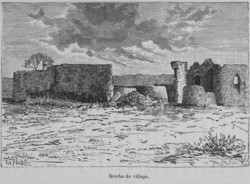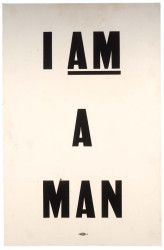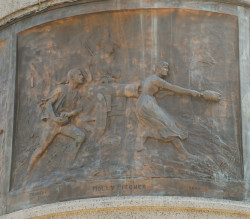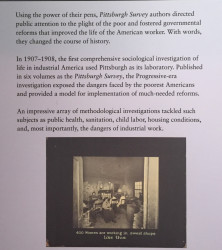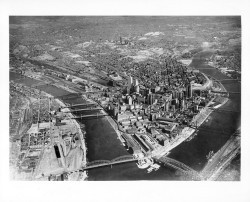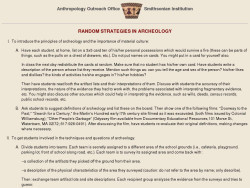ufn44 uln44
Social Studies teacher
Pittsburgh CAPA
Middle School (13 to 15 years old), High School (16 to 18 years old)
Teacher/Educator
Language Arts And English, Civics, Literature, Cultures, Economics, Social Studies, Geography, Writing, US History, Arts, Other
I'm a history-lover, art fan, and bookworm. I taught high school history (U.S. History and World Religions) for ten years in North Carolina, teach currently in Pittsburgh, PA, and am working to help teachers make the most of this new resource!
ufn44 uln44's collections
Resistance to Slavery
<p>This collection includes items representing various forms of resistance and rebellion to enslavement. Students should determine what kind of actions are pictured in the case of each item and use them to create a robust definition of resistance to slavery. </p>
<p>Guiding Questions:</p>
<ul><li>What does it mean to "resist" slavery? Give examples of how enslaved people sought freedom in each of these categories: theft and property destruction, maintaining the family, culture/religion/music/education, running away, revolt, and resistance at work. </li><li>How did white slave-owners respond to such actions? </li><li>Is maintaining a distinct cultural heritage a form of resistance? Why or why not? </li><li>How do religion, art, and music encourage resistance?</li></ul>
<p>Note that while some items in this collection come from later periods, this collection has been adapted for use in a lesson during the colonial period and focuses on examples of resistance in the 1600s and early 1700s. </p>
 ufn44 uln44
ufn44 uln44
21
I Am a Man--We Are Human
This collection traces how a powerful phrase and its variations have been adopted by different voices in United States history.
Questions to consider:
-How is the phrase (and/or design of the original poster) used? How do the changes and adaptations it has undergone reflect different time periods and issues in United States history?
-Why has the phrase "I am a Man" had such staying power? Alternately, why has "We Are Human" been adopted?
-How do the above phrases reflect or reject concepts like "separateness," "personal identity," or "inclusion"?
-Why do you think many artists are drawn to the phrase and design? Do you think the artists expect viewers to recognize the influence of the original work? Why or why not?
-Why is the verb underlined? How would it change if another word were emphasized?
-What other examples could be included in this collection? This collection focuses primarily on visual interpretations of the phrase. Can you think of literary or pop culture examples?
Tags: Ernest Withers, Dread Scott, Ferguson, Abolition, Sojourner Truth, Memphis, sanitation workers, immigration reform, refugee crisis, Hank Willis Thomas, protest, sign, placard, broadside, civil rights
 ufn44 uln44
ufn44 uln44
9
Women and Gender During the Revolutionary War
<p>The Revolutionary War was an interesting time for women, women served in a lot of conventional ways such as cooks, maids, and nurses; however, women also served in a lot of unconventional ways such as spies and even soldiers. Race was also a factor in when accounting for the roles that women played. The following items are a small symbolic representation of the many various contributions that women made during the Revolutionary War.</p>
<p>Some additional source material:</p>
<p><a href="http://www.history.org/History/teaching/enewsletter/volume7/nov08/women_revarmy.cfm">http://www.history.org/History...</a></p>
<p><a href="http://score.rims.k12.ca.us/score_lessons/women_american_revolution/">http://score.rims.k12.ca.us/sc...</a><br></p>
<p><a href="http://www.historycentral.com/Revolt/Americans/Women.html">http://www.historycentral.com/...</a><br></p>
<p><a href="https://allthingsliberty.com/2013/10/10-amazing-women-revolutionary-war/">https://allthingsliberty.com/2...</a><br></p>
<p><a href="https://www.revolutionary-war.net/revolutionary-war-women.html">https://www.revolutionary-war....</a><br></p>
 ufn44 uln44
ufn44 uln44
12
Booker T. Washington and the Tuskegee Institute
<p>This collection includes photographs and paintings that reveal information about Booker T. Washington's strategy for achieving civil rights for African-Americans, and about the subjects taught at Tuskegee. It is intended as an introductory activity on the subject, to be completed by students.</p><p>Tags: point of view, Reconstruction, Tuskegee Institute, civil rights, segregation, Gilded Age, cause effect</p>
 ufn44 uln44
ufn44 uln44
5
Emmett Till: Confronting a Difficult History
This collection looks at how a tragic incident like the murder of Emmett Till is remembered in American history and national memory, as well as the significance of the decision of Till's mother, Mamie Mobley-Till, to share her son's loss publicly with an open-casket. Her actions created a galvanizing moment for the modern civil rights movement, heightening its significance and influence. The collection includes photographs, art work, and two newspaper articles about modern memorials to Till and other lynching victims.
Teachers might use the following images as the basis for silent discussion (see the Big Paper strategy from Facing History, included on the last resource) prior to a group conversation on the following questions:
-How did this case impact the civil rights movement?
-What were the effects of having an open casket at Till's funeral? How does media continue to impact the civil rights movement?
-How should Emmett Till be remembered and honored? How should his mother be remembered and honored?
-Should national memorials and museums include objects like Till's original casket or the soil from lynching sites? Why or why not?
 ufn44 uln44
ufn44 uln44
6
Ekphrastic Poetry Lesson
<p>According to <a href="https://www.poetryfoundation.org/resources/learning/glossary-terms/detail/ekphrasis" target="_blank">the Poetry Foundation</a>, "An ekphrastic poem is a vivid description of a scene or, more commonly, a work of art. Through the imaginative act of narrating and reflecting on the "action" of a painting or sculpture, the poet may amplify and expand its meaning"</p><p>This collection is based on a lesson plan from the Smithsonian American Art Museum, which guides users through the process of using artwork to inform and inspire poetry. Strategies for developing original poems, sample ekphrastic (art-inspired) poems, and suggested artworks are included to stimulate thinking.</p><p>tags: creative writing, art, poetry, poems</p>
 ufn44 uln44
ufn44 uln44
9
"Women's Work"
<p>This collection explores the conception of "women's work" and challenges users to think about whether such a phrase has meaning. </p><p>Teachers and students can use the collection in a number of ways: grouping or sorting the resources chronologically to explore change over time; writing definitions of "women's work" for different time periods; completing image or text analysis on individual resources; or researching women's contributions in a particular field. </p><p>This is a work-in-progress based on the digitized materials within the Smithsonian Learning Lab's collection--it is not meant to be wholly definitive or authoritative. In fact, this could be a point of discussion: what, or who, do you think is missing from this collection?<br /></p>
 ufn44 uln44
ufn44 uln44
35
Nixon in Political Cartoons
<p>This collection includes nine political cartoons about Richard Nixon's presidency and the Watergate scandal, as well as a cartoon analysis worksheet from the National Archives and Record Administration and a link to more cartoons about Nixon at the Library of Congress.</p><p>Teachers may use this collection in many ways: by assigning individual students or groups cartoons to analyze and share with the class via presentations, using the "jigsaw" format to create expert groups on each cartoon and then share information that way, or by creating a gallery walk of cartoons for students to work on individually. Students might even create their own political cartoon about the Nixon presidency, focusing on one of several topics: Watergate, ping-pong diplomacy, detente, visit to Moscow, environmental protections, the "southern strategy," busing, his relationship with the press, Vietnam, and more. </p>
 ufn44 uln44
ufn44 uln44
11
Pittsburgh's Urban Renewal
<p>This collection was created to support a workshop on integrating primary sources and student writing for teachers at Peters Township High School. These resources can be used to design a document-based question to answer the following inquiry:</p><p>Were Pittsburgh's urban renewal programs in the 1950s and 60s ultimately helpful or harmful?</p><p>Teachers may want to excerpt the documents included in this collection before giving them to students to use. You may also want to introduce students to the concept of "purposeful annotation" as they read through the documents (resources included).</p><p>Finally, an articles on urban renewal today and a lesson plan from Global Oneness Project on gentrification and urban renewal in Seattle provide additional resources for teachers.</p><p>Tags: C3, Inquiry, urban renewal, demolition, construction, slums, Teenie Harris, Charles Olmstead, Pittsburgh</p>
 ufn44 uln44
ufn44 uln44
17
The Maya People Today
This collection includes many videos, in English and Spanish, and resources showing how the Mayan people living today have preserved their traditions while adjusting to modern life. Students can use the collection to learn about the values and traditions that remain important in Mayan life today.
Those who want to learn more about the ancient Maya should view this collection:
https://learninglab.si.edu/collections/the-achievements-of-ancient-mayan-civilization/Cb7G8r7LdVF6mGqm
 ufn44 uln44
ufn44 uln44
23
Archaeology Lessons
This collection includes lesson plans and artifact collections that would be useful for any K-12 study of archaeology. Brief descriptions of the resources are included where necessary, so that teachers can quickly determine what might be applicable to their own classrooms.
 ufn44 uln44
ufn44 uln44
14

